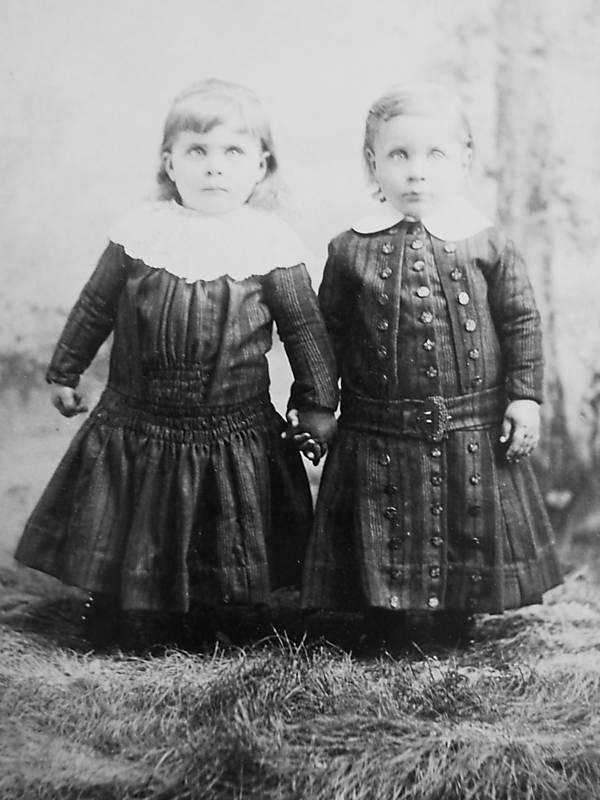
American Boy Dresses: Gender Styling--Elements

Figure 1.--This is a very valuable portrait because the unidentified children seem to be twins. Thus the different stylistic elements n the dresses are likely to be the mother's assessment of gender suitability. The photographer was Trevaskis, Hazleton, Pennsylvania. The cabinent card portrait uis not dated, but looks to have been made in the 1880s. Note how the boy's dress has the appearance of front buttoning, copious use of buttons, and belt as a waist device. Note that mother has used the same material for both dresses.
|
|
We notice a range of elenents that were used to differentiate boy dresses from girl dresses. It shouldbe stressed that they were not uniformily utilized by mothers at the time, but the photographic record shows that they were commonly used by many mothers. And as many dresses were sewn at home or by seamstresses and not bought readymade, mothers had the ability to chose the stylistic elements for each child. The most important destinctive feature was that boy styles were more plain than those worn by girls. Here the Fauntleroy Craze of the 1880s introduced a complicating element. They were also more likely to have front buttons. In fact, buttons were much more common on boy dresses. Belts and defined waistlines were also more common for boy dresses. We also see styilized jackets, presumably emulating the jackets of kilt suits which were worn by boys. This is not to say that such elenents did not asppear in the dresses worn by girls. It is to say that they were generally more important in the dresses worn by boys. Color may have been another factor, but this is much more difficult to assess in period black-and-white photography. Accessories are a stylistic element to consider. Floppy bows were more common for boys than girls. Lace collsars are more complicated. And modern color conventions were not yet well wsrtablished in the 19th century. As conventions for boy dresses varied from family to family, the most valuable images for evaluating these conventions are family portraits. When trying to assess unidentified portraits, the reader should not use any single element as definitive, but rather assess how many of the different elements are found. And hair styling can be used as conformation.
Prevalence
We notice a range of elenents that were used to differentiate boy dresses from girl dresses. It shouldbe stressed that they were not uniformily utilized by mothers at the time, but the photographic record shows that they were commonly used by many mothers.
Availabilkity
We believe that many boy dresses were sewn at home or by seamstresses and not bought ready made. Ready made dresses were readily available durung the late-29th century, but we believe they were mosdtly girl styles. If mothers wanted biy dresses they had ti sew them or order them frim seemstresses. Thus mothers had the ability to chose the stylistic elements they desired for each child.
Destuinctive Elements
We notice several destinctive elements to boy-styled dresses. The most important destinctive feature was that boy styles were more plain than those worn by girls. Here the Fauntleroy Craze of the 1880s introduced a complicating element. They were also more likely to have front buttons. In fact, buttons were much more common on boy dresses. Belts and defined waistlines were also more common for boy dresses. We also see styilized jackets, presumably emulating the jackets of kilt suits which were commonly worn by the younger boys most apt to wear dresses. This is not to say that such elenents did not asppear in the dresses worn by girls. It is to say that they were generally more important in the dresses worn by boys. Color may have been another factor, but this is much more difficult to assess in period black-and-white photography. Accessories are a stylistic element to consider. Floppy bows were more common for boys than girls. Lace collsars are more complicated. And modern color conventions were not yet well wsrtablished in the 19th century. As conventions for boy dresses varied from family to family, the most valuable images for evaluating these conventions are family portraits. When trying to assess unidentified portraits, the reader should not use any single element as definitive, but rather assess how many of the different elements are found. And hair styling can be used as conformation.
HBC

Navigate the Historic Boys' Clothing Web dress pages:
[Return to the Main American boy dress styling page]
[Return to the Main U.S. national dress style page]
[Return to the Main U.S. national dress style page]
[Pinafores]
[Ringlet curls]
[Smocks]
[Bodice kilts]
[Kilts]
[Fauntleroy dresses]
[Sailor dresses]
[Fancy dresses]
[Dresses: 16th-18th centuries]
[Dresses: Early-Mid-19th century]
[Dresses: Late-19th century]
[Dresses: Early 20th century]
[Difficult images]
[Movie dresses]
Navigate the Boys' Historical Clothing Web Site:
[Introduction]
[Activities]
[Biographies]
[Chronology]
[Clothing styles]
[Countries]
[Bibliographies]
[Contributions]
[Essays]
[FAQs]
[Glossaries]
[Images]
[Links]
[Registration]
[Tools]
[Boys' Clothing Home]
Created: 2:09 AM 7/21/2009
Last updated: 5:27 AM 7/27/2012



